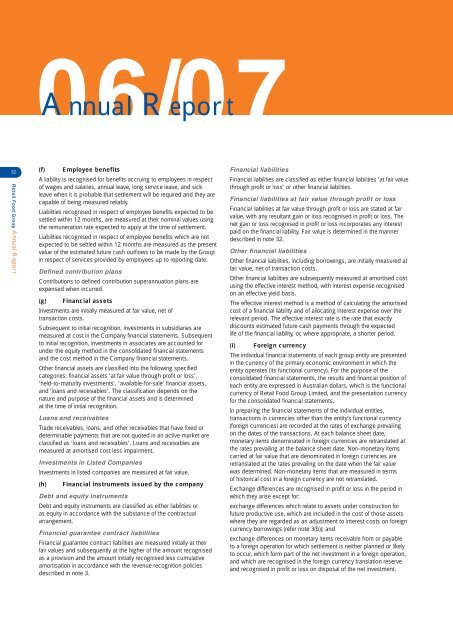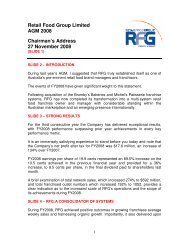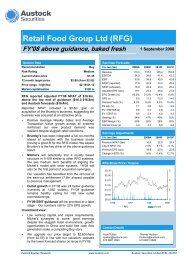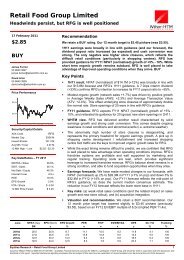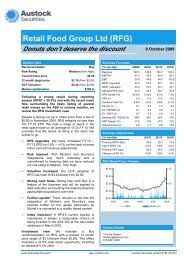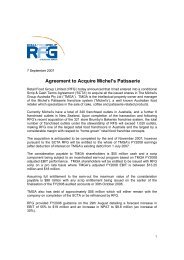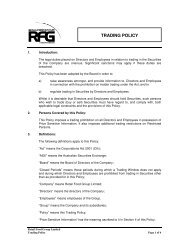RFG Annual Report 2007 - Retail Food Group
RFG Annual Report 2007 - Retail Food Group
RFG Annual Report 2007 - Retail Food Group
You also want an ePaper? Increase the reach of your titles
YUMPU automatically turns print PDFs into web optimized ePapers that Google loves.
06/07<br />
<strong>Annual</strong> <strong>Report</strong><br />
32<br />
<strong>Retail</strong> <strong>Food</strong> <strong>Group</strong> <strong>Annual</strong> <strong>Report</strong><br />
(f) Employee benefits<br />
A liability is recognised for benefi ts accruing to employees in respect<br />
of wages and salaries, annual leave, long service leave, and sick<br />
leave when it is probable that settlement will be required and they are<br />
capable of being measured reliably.<br />
Liabilities recognised in respect of employee benefi ts expected to be<br />
settled within 12 months, are measured at their nominal values using<br />
the remuneration rate expected to apply at the time of settlement.<br />
Liabilities recognised in respect of employee benefi ts which are not<br />
expected to be settled within 12 months are measured as the present<br />
value of the estimated future cash outfl ows to be made by the <strong>Group</strong><br />
in respect of services provided by employees up to reporting date.<br />
Defined contribution plans<br />
Contributions to defi ned contribution superannuation plans are<br />
expensed when incurred.<br />
(g) Financial assets<br />
Investments are initially measured at fair value, net of<br />
transaction costs.<br />
Subsequent to initial recognition, investments in subsidiaries are<br />
measured at cost in the Company fi nancial statements. Subsequent<br />
to initial recognition, investments in associates are accounted for<br />
under the equity method in the consolidated fi nancial statements<br />
and the cost method in the Company fi nancial statements.<br />
Other fi nancial assets are classifi ed into the following specifi ed<br />
categories: fi nancial assets ‘at fair value through profi t or loss’,<br />
‘held-to-maturity investments’, ‘available-for-sale’ fi nancial assets,<br />
and ‘loans and receivables’. The classifi cation depends on the<br />
nature and purpose of the fi nancial assets and is determined<br />
at the time of initial recognition.<br />
Loans and receivables<br />
Trade receivables, loans, and other receivables that have fi xed or<br />
determinable payments that are not quoted in an active market are<br />
classifi ed as ‘loans and receivables’. Loans and receivables are<br />
measured at amortised cost less impairment.<br />
Investments in Listed Companies<br />
Investments in listed companies are measured at fair value.<br />
(h)<br />
Financial instruments issued by the company<br />
Debt and equity instruments<br />
Debt and equity instruments are classifi ed as either liabilities or<br />
as equity in accordance with the substance of the contractual<br />
arrangement.<br />
Financial guarantee contract liabilities<br />
Financial guarantee contract liabilities are measured initially at their<br />
fair values and subsequently at the higher of the amount recognised<br />
as a provision and the amount initially recognised less cumulative<br />
amortisation in accordance with the revenue recognition policies<br />
described in note 3.<br />
Financial liabilities<br />
Financial liabilities are classifi ed as either fi nancial liabilities ‘at fair value<br />
through profi t or loss’ or other fi nancial liabilities.<br />
Financial liabilities at fair value through profit or loss<br />
Financial liabilities at fair value through profi t or loss are stated at fair<br />
value, with any resultant gain or loss recognised in profi t or loss. The<br />
net gain or loss recognised in profi t or loss incorporates any interest<br />
paid on the fi nancial liability. Fair value is determined in the manner<br />
described in note 32.<br />
Other financial liabilities<br />
Other fi nancial liabilities, including borrowings, are initially measured at<br />
fair value, net of transaction costs.<br />
Other fi nancial liabilities are subsequently measured at amortised cost<br />
using the effective interest method, with interest expense recognised<br />
on an effective yield basis.<br />
The effective interest method is a method of calculating the amortised<br />
cost of a fi nancial liability and of allocating interest expense over the<br />
relevant period. The effective interest rate is the rate that exactly<br />
discounts estimated future cash payments through the expected<br />
life of the fi nancial liability, or, where appropriate, a shorter period.<br />
(i) Foreign currency<br />
The individual fi nancial statements of each group entity are presented<br />
in the currency of the primary economic environment in which the<br />
entity operates (its functional currency). For the purpose of the<br />
consolidated fi nancial statements, the results and fi nancial position of<br />
each entity are expressed in Australian dollars, which is the functional<br />
currency of <strong>Retail</strong> <strong>Food</strong> <strong>Group</strong> Limited, and the presentation currency<br />
for the consolidated fi nancial statements.<br />
In preparing the fi nancial statements of the individual entities,<br />
transactions in currencies other than the entity’s functional currency<br />
(foreign currencies) are recorded at the rates of exchange prevailing<br />
on the dates of the transactions. At each balance sheet date,<br />
monetary items denominated in foreign currencies are retranslated at<br />
the rates prevailing at the balance sheet date. Non-monetary items<br />
carried at fair value that are denominated in foreign currencies are<br />
retranslated at the rates prevailing on the date when the fair value<br />
was determined. Non-monetary items that are measured in terms<br />
of historical cost in a foreign currency are not retranslated.<br />
Exchange differences are recognised in profi t or loss in the period in<br />
which they arise except for:<br />
exchange differences which relate to assets under construction for<br />
future productive use, which are included in the cost of those assets<br />
where they are regarded as an adjustment to interest costs on foreign<br />
currency borrowings (refer note 3(b)); and<br />
exchange differences on monetary items receivable from or payable<br />
to a foreign operation for which settlement is neither planned or likely<br />
to occur, which form part of the net investment in a foreign operation,<br />
and which are recognised in the foreign currency translation reserve<br />
and recognised in profi t or loss on disposal of the net investment.


